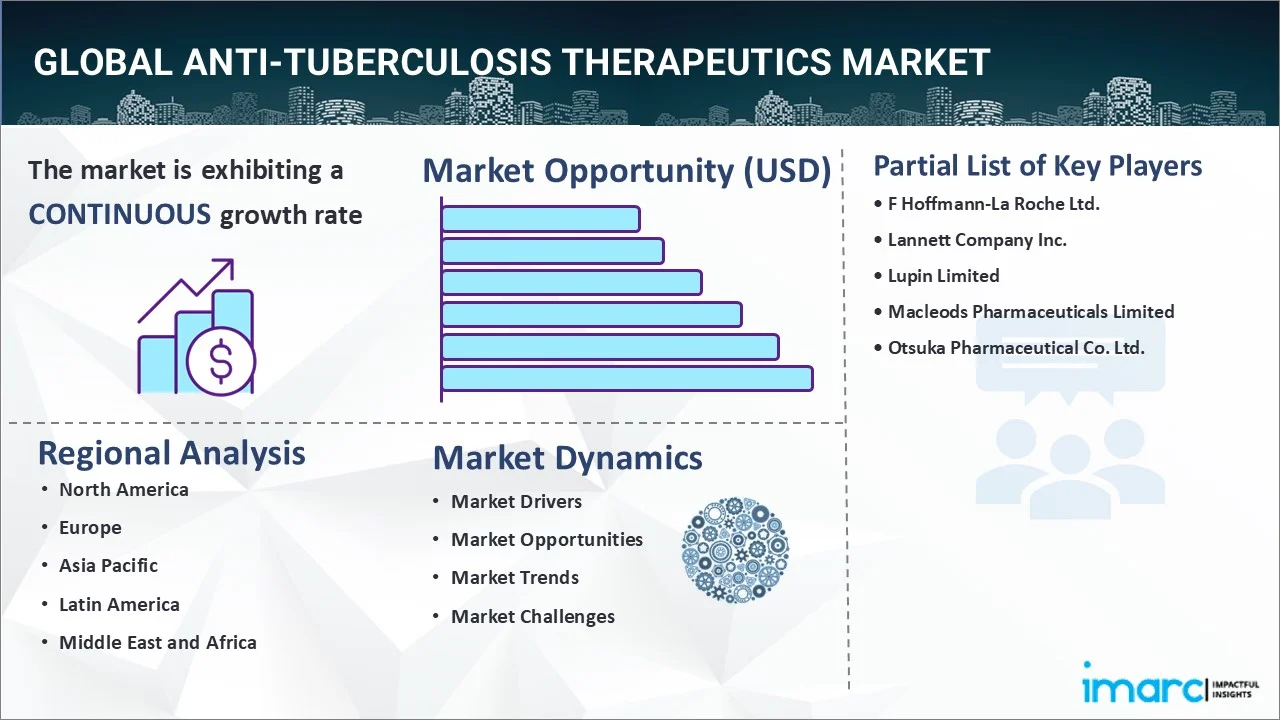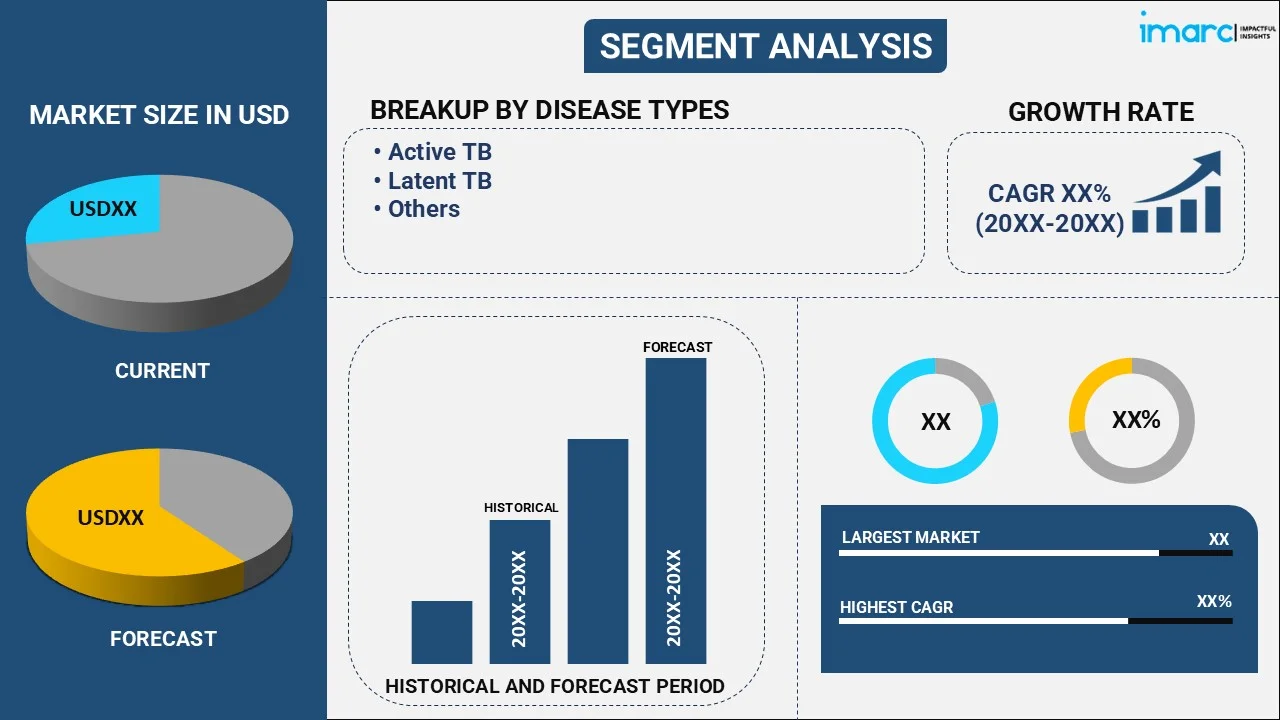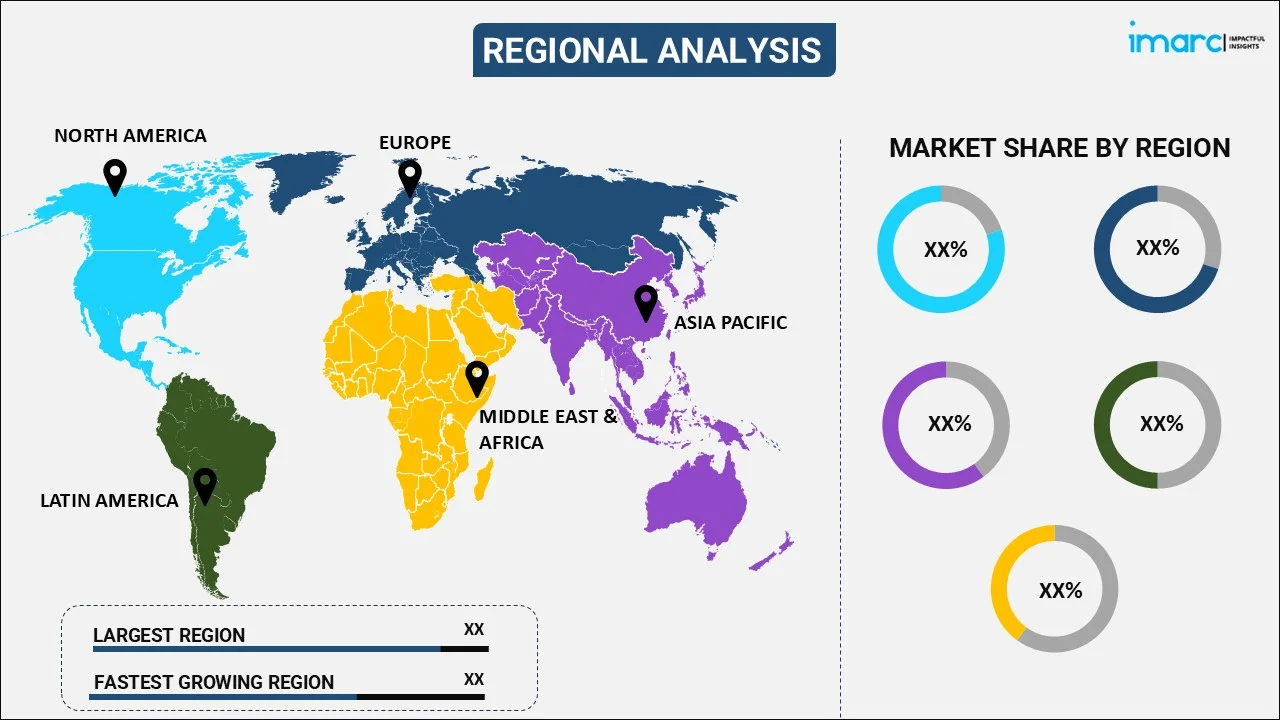
Anti-Tuberculosis Therapeutics Market Report by Disease Type (Active TB, Latent TB, and Others), Diagnosis and Treatment (Diagnosis, Treatment), End User (Hospitals, Specialty Clinics, Homecare, and Others), and Region 2025-2033
Market Overview:
The global anti-tuberculosis therapeutics market size reached USD 1,530.1 Million in 2024. Looking forward, IMARC Group expects the market to reach USD 2,552.2 Million by 2033, exhibiting a growth rate (CAGR) of 5.56% during 2025-2033. The rising healthcare spending, favorable reimbursement policies, technological advancements, and growing public-private partnerships represent some of the key factors driving the market.
|
Report Attribute
|
Key Statistics
|
|---|---|
|
Base Year
|
2024
|
|
Forecast Years
|
2025-2033
|
|
Historical Years
|
2019-2024
|
|
Market Size in 2024
|
USD 1,530.1 Million |
|
Market Forecast in 2033
|
USD 2,552.2 Million |
| Market Growth Rate 2025-2033 | 5.56% |
Anti-tuberculosis therapeutics refer to the drugs and treatment strategies used to manage tuberculosis (TB), a bacterial infection caused by Mycobacterium tuberculosis. TB primarily affects the lungs and can also spread to other parts of the body, such as the kidneys, spine, and brain. Anti-tuberculosis therapeutics are used to eradicate the bacteria from the body and prevent the spread of the infection. This is achieved through a combination of antibiotics that are typically prescribed for six to nine months. Some of the most commonly used drugs include isoniazid, rifampin, ethambutol, and pyrazinamide. The exact combination of drugs used depends on the severity of the infection and the patient's health status. In addition, regular monitoring and follow-up are also essential to ensure treatment success and prevent the development of drug-resistant TB.
One of the primary factors driving the market is the high prevalence of tuberculosis (TB) worldwide, particularly in low- and middle-income countries. Additionally, the growing incidence of drug-resistant TB due to incomplete treatment, inadequate healthcare infrastructure, and lack of access to appropriate healthcare is positively influencing the anti-tuberculosis therapeutics market growth.

Anti-Tuberculosis Therapeutics Market Trends:
Advancements in Drugs
In recent years, anti-tuberculosis therapeutics have gained traction as they also involve supportive care, such as oxygen therapy, nutrition support, and management of complications that may arise. Consequently, the development of new drugs and treatment strategies is creating new growth opportunities for the market participants. In recent years, several new drugs, such as bedaquiline and delamanid, have been approved for the treatment of tuberculosis. These drugs offer improved efficacy and safety profiles compared to traditional TB drugs. In line with this, advancements in technology and diagnostics have enabled early detection and diagnosis of tuberculosis, leading to timely initiation of treatment and better patient outcomes.
Increasing Healthcare Spending and Government Support
The increasing healthcare spending, particularly in emerging economies, has led to improved healthcare infrastructure and increased access to quality healthcare, including TB treatment. Apart from this, the growing awareness about TB and the importance of early diagnosis and treatment have also escalated the demand for anti-tuberculosis therapeutics. Moreover, government initiatives and funding for TB control programs have played a significant role in driving the anti-tuberculosis therapeutics market. For instance, governments and non-governmental organizations (NGOs) are working together to increase awareness, improve diagnosis, and ensure access to affordable and effective treatments, which is expected to drive market growth in the upcoming years.
Surge in R&D Activities
An uptick in the number of research and development initiatives is augmenting the market potential. Such activities are expected to offer lucrative opportunities for market growth. Moreover, the increasing number of new drug approvals and drug enhancement will further fuel the market demand. The emergence of new and more effective treatments for diabetes and early disease diagnosis is also opportunistic for the market. Growth in investments for the development of novel treatments and an increase in the adoption of anti-tuberculosis therapeutics in emerging markets will further present opportunities for growth during the forecast period.
Key Market Segmentation:
IMARC Group provides an analysis of the key trends in each segment of the global anti-tuberculosis therapeutics market, along with forecasts at the global, regional, and country levels from 2025-2033. Our report has categorized the market based on the disease type, diagnosis and treatment, and end user.
Disease Type Insights:

- Active TB
- Latent TB
- Others
The anti-tuberculosis therapeutics market report has provided a detailed breakup and analysis of the market based on the disease type. This includes active TB, latent TB, and others.
Diagnosis and Treatment Insights:
- Diagnosis
- Blood Tests
- Imaging Tests
- Sputum Tests
- Others
- Treatment
- First-Line of Drugs
- Isoniazid
- Ethambutol
- Rifampin
- Others
- Second-Line of Drugs
- Thiacetazone
- Paraaminosalicyclic Acid (PAS)
- Others
- Others
- First-Line of Drugs
A detailed breakup and analysis of the anti-tuberculosis therapeutics market based on the diagnosis and treatment has also been provided in the report. This includes diagnosis (blood tests, imaging tests, sputum tests, and others), treatment (first-line of drugs (isoniazid, ethambutol, rifampin, and others) second-line of drugs (thiacetazone, paraaminosalicyclic acid (PAS), and others), and others
End User Insights:
- Hospitals
- Specialty Clinics
- Homecare
- Others
The report has provided a detailed breakup and analysis of the anti-tuberculosis therapeutics market based on the end user. This includes hospitals, specialty clinics, homecare, and others.
Regional Insights:

- North America
- United States
- Canada
- Europe
- Germany
- France
- United Kingdom
- Italy
- Spain
- Russia
- Others
- Asia Pacific
- China
- Japan
- India
- South Korea
- Australia
- Indonesia
- Others
- Latin America
- Brazil
- Mexico
- Others
- Middle East and Africa
The report has also provided a comprehensive analysis of all the major regional markets, which include North America (the United States and Canada); Europe (Germany, France, the United Kingdom, Italy, Spain, Russia, and others); Asia Pacific (China, Japan, India, South Korea, Australia, Indonesia, and others); Latin America (Brazil, Mexico, and others); and the Middle East and Africa. According to the report, North America was the largest market for anti-tuberculosis therapeutics. Some of the factors driving the North America anti-tuberculosis therapeutics market included rising prevalence of tuberculosis, growing drug resistance, and numerous government initiatives.
Competitive Landscape:
The report has also provided a comprehensive analysis of the competitive landscape in the global anti- tuberculosis therapeutics market. Detailed profiles of all major companies have also been provided. Some of the companies covered include:
- F Hoffmann-La Roche Ltd.
- Lannett Company Inc.
- Lupin Limited
- Macleods Pharmaceuticals Limited
- Otsuka Pharmaceutical Co. Ltd.
Kindly note that this only represents a partial list of companies, and the complete list has been provided in the report.
Report Coverage:
| Report Features | Details |
|---|---|
| Base Year of the Analysis | 2024 |
| Historical Period | 2019-2024 |
| Forecast Period | 2025-2033 |
| Units | Million USD |
| Disease Types Covered | Active TB, Latent TB, Others |
| Diagnosis and Treatments Covered |
|
| End Users Covered | Hospitals, Specialty Clinics, Homecare, Others |
| Regions Covered | Asia Pacific, Europe, North America, Latin America, Middle East and Africa |
| Countries Covered | United States, Canada, Germany, France, United Kingdom, Italy, Spain, Russia, China, Japan, India, South Korea, Australia, Indonesia, Brazil, Mexico |
| Companies Covered | F Hoffmann-La Roche Ltd., Lannett Company Inc., Lupin Limited, Macleods Pharmaceuticals Limited, Otsuka Pharmaceutical Co. Ltd., etc. |
| Customization Scope | 10% Free Customization |
| Post-Sale Analyst Support | 10-12 Weeks |
| Delivery Format | PDF and Excel through Email (We can also provide the editable version of the report in PPT/Word format on special request) |
Key Questions Answered in This Report:
- How has the global anti-tuberculosis therapeutics market performed so far, and how will it perform in the coming years ?
- What are the drivers, restraints, and opportunities in the global anti-tuberculosis therapeutics market ?
- What is the impact of each driver, restraint, and opportunity on the global anti-tuberculosis therapeutics market ?
- What are the key regional markets ?
- Which countries represent the most attractive anti-tuberculosis therapeutics market ?
- What is the breakup of the market based on the disease type ?
- Which is the most attractive disease type in the anti-tuberculosis therapeutics market ?
- What is the breakup of the market based on the diagnosis and treatment ?
- Which is the most attractive diagnosis and treatment in the anti-tuberculosis therapeutics market ?
- What is the breakup of the market based on end user ?
- Which is the most attractive end user in the anti-tuberculosis therapeutics market ?
- What is the competitive structure of the global anti-tuberculosis therapeutics market ?
- Who are the key players/companies in the global anti-tuberculosis therapeutics market ?
Key Benefits for Stakeholders:
- IMARC’s report offers a comprehensive quantitative analysis of various market segments, historical and current market trends, market forecasts, and dynamics of the anti-tuberculosis therapeutics market from 2019-2033.
- The research study provides the latest information on the market drivers, challenges, and opportunities in the global anti-tuberculosis therapeutics market.
- The study maps the leading, as well as the fastest-growing, regional markets. It further enables stakeholders to identify the key country-level markets within each region.
- Porter's five forces analysis assist stakeholders in assessing the impact of new entrants, competitive rivalry, supplier power, buyer power, and the threat of substitution. It helps stakeholders to analyze the level of competition within the anti-tuberculosis therapeutics industry and its attractiveness.
- Competitive landscape allows stakeholders to understand their competitive environment and provides an insight into the current positions of key players in the market.
Need more help?
- Speak to our experienced analysts for insights on the current market scenarios.
- Include additional segments and countries to customize the report as per your requirement.
- Gain an unparalleled competitive advantage in your domain by understanding how to utilize the report and positively impacting your operations and revenue.
- For further assistance, please connect with our analysts.
 Request Customization
Request Customization
 Speak to an Analyst
Speak to an Analyst
 Request Brochure
Request Brochure
 Inquire Before Buying
Inquire Before Buying




.webp)




.webp)












